
Title
Why
Clinicians use laboratory results to make a clinical decision. In order to do this correctly clinicians have to know when a result indicates that a patient is ill. For this he/she has to know the biological reference interval or decision value for each examination. The clinician uses this value, or this interval, to decide whether a result of a certain examination is positive or negative. It is the responsibility of the laboratory to provide the clinicians with the correct biological reference intervals or decision values of all the examinations performed. These values must be representative for the population served by the laboratory and where necessary take into account factors such as age, sex or HIV-status.
If applicable for certain examinations the laboratory must also provide “alert or critical intervals”. If the result falls within this interval it has direct consequences for the urgency with which patients must be treated and the physician must be notified immediately.
What
Document the biological reference interval or decision value of each examination performed by the laboratory. Examples of biological reference intervals are:
- The central 95% biological reference interval for sodium ion concentration values in serum from a population of healthy male and female adults is 135 mmol/l to 145 mmol/l (source: ISO 15189:2012)
- The intervals defining the severity of tuberculosis infection using smear microscopy are (source: International Union Against Tuberculosis and Lung Disease/World Health Organization):
- Scanty: 1-9 acid-fast bacilli (AFB) per 100 high power fields (HPF)
- +1: 10-99 AFB per 100 HPF
- +2: 1-10 AFB per HPF
- +3: >10 AFB per HPF
Note that for some examinations the biological reference intervals may vary per population and may be different for different populations of human beings around the world. It is extremely important to provide the clients of the laboratory with the correct values. No matter how good laboratory testing is performed, if incorrect biological reference intervals/decision values are provided to the clients an incorrect diagnosis may still be made, making all the efforts to provide a quality laboratory result useless.
In addition to determining the biological reference intervals you must also determine "alert or critical intervals". If the result of an examination falls within this interval it has direct consequences for the treatment of the patient and the requester must be notified immediately.
As the biological reference intervals/decision values and alert/critical interval values are most important for the clients of the laboratory, document these values in the Laboratory Service Manual. This manual will be developed in the next activity. Indicate these values also on the Laboratory Result Report format that is also developed in phase 2) so that clinicians directly see the biological reference intervals and critical intervals together with the result of laboratory testing. This ensures that the clinicians always use the correct values to make a diagnostic decision. When the Laboratory Service Manual is reviewed as part of the routine document control procedure it is important that the reviewers verify whether the biological reference intervals/decision values and alert/critical interval values are still correct for each examination.
How & who
Laboratory Manager:
- Determine for each examination performed by the laboratory the biological reference interval/decision value and the alert/critical interval value (the latter may not be applicable to every examination).
- Include the intervals for all the examinations performed by the laboratory in the Laboratory Result Report format (click to go to activity on developing the Laboratory Result Report format).
- In the next activity the Laboratory Service Manual is developed: include the biological reference intervals/decision values and alert/critical interval values for all the examinations performed by the laboratory.
- When the Laboratory Service Manual is reviewed as part of the document control system, the correctness of the biological reference intervals/decision values always need to be verified. If changes have occurred, adapt the values in both the Laboratory Service Manual and the Laboratory Result Report format directly.
- If the methodology of examinations is changed verify if the biological reference intervals/decision values are still correct. If not, adapt them directly in both the Laboratory Service Manual and the Laboratory Result Report format. Distribute the new version of the Laboratory Service Manual directly to all the clients of the laboratory.

